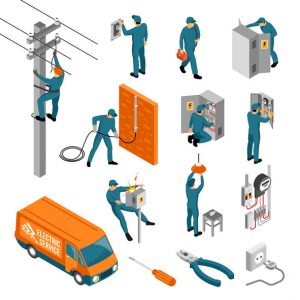
The electrical trade has long been associated with high earning power, consistently landing a top spot among the most in-demand and highest-paid trades. That might be the National Electrical Contractors Association saying that, but it bears out in the numbers. This business is massive, valued at more than $171 billion annually and consisting of more than 70,000 electrical contracting firms and more than 650,000 workers.
You’ve probably heard about the shortage of wiremen in the construction industry, and it’s true—America is in the midst of an unprecedented skilled labor shortage, and electricians are front and center among the tradesmen whose essential skills are in high demand. For anyone with that magic combination of some natural technical inclination, an eye for detail, and problem solving skills, this could very well be the perfect trade.
Electrician Pay Rates: Top Earners According to Industry and Location
Understanding Prevailing Wage and Sorting Out the Factors that Affect What Electricians Earn
From the Ground Up with Room to Grow: Apprentice Vs Journeyman Electrician Pay
State-by-State Guide to Electrician Salaries and Hourly Wages
Industrial, commercial, and residential construction and high-tech retrofits all drive demand in this skilled trade, plus it comes with the kind of job security that tends to be lacking in so many other professions. In fact, a 2018 State of the Industry report by Klein Tools revealed that nearly half of all young electricians chose the field for its job security. Employment projections from the Bureau of Labor Statistics (BLS) show a growth rate of about 10% between 2018 and 2028, much faster than average for all job classifications and, according to some estimates, the industry will experience a labor shortage of about 60,000 workers by 2026. That’s a shortage that tradesmen like you will help fill.
The bulk of our nation’s skilled labor force is gearing up for retirement, and there’s simply not enough supply to fill this impending void in the workforce. While this has created – and will continue to create – real challenges for employers, it’s nothing but good news for aspiring and practicing electricians as professional opportunities remain more abundant and more lucrative than ever.
Electrician Pay Rates: Top Earners According to Industry and Location
The BLS reports that as of May 2019, electricians earned an average of $56,180 a year ($27.01/hour), and the top earners in the trade (top 10%) made an average of $96,580 ($46.43/hour).
Despite the fact that fracking has become a curse word to a lot of people, the natural gas industry continues to grow thanks to abundant gas resources and technical innovations in the way it’s extracted and distributed. It comes as little surprise that electricians in this industry are among the highest paid, posting a mean, annual income of $104,250, according to May 2019 BLS stats.
Event promotion companies that put on concerts and sporting events also posted some of the strongest pay rates for the electricians they staff, at $86,820 on average that year.
Electricians working for companies involved in real estate subdivision, splitting land into lots for housing developments, also do well, earning an average of $82,630 as of 2019.
Strong average annual incomes can also be found in a number of other industries, including:
- Building equipment contractors: $59,790
- Coal mining: $61,200
- Local government: $69,850
The top-paying states for electricians, as of May 2019 were:
- Washington D.C.: $79,870
- New York: $79,480
- Illinois: $78,790
- Hawaii: $77,530
- Alaska: $75,350
The top-paying metro areas for electricians, according to annual mean salary, during this time included:
- San Francisco (includes Oakland and Hayward), CA: $100,400
- Trenton, NJ: $84,950
- Mount Vernon (includes Anacortes), WA: $84,810
- Lewiston, ID/WA: $83,910
- New York City (includes Newark, Jersey City, NJ), NY: $82,640
- Chicago (includes Naperville, Elgin), IL: $81,320
Sorting Out the Career Paths and Other Factors that Affect What Electricians Earn

A number of factors influence how much you can earn as an electrician:
Residential vs. Commercial vs. Industrial
Recent stats show industrial electricians earn slightly more than their residential and commercial counterparts.
According to a 2018 salary survey published by the National Center for Construction Education & Research (NCCER), the average salary for commercial electricians servicing retailers and other businesses was $61,139, while industrial electricians working largely in manufacturing plants and for logistics operations was $67,269. The BLS reports that residential electricians earned a similar average salary of $61,300 in 2019.
Union vs. Non-Union
Union wages tend to be higher than non-union wages. According to the International Brotherhood of Electrical Workers (IBEW), union electricians earn, on average, $37.69/hour or $78,395 annually, compared to just $27.07/hour or $56,305 annually among non-union electricians.
A 2016 report by the Midwest Economic Policy Institute found that union workers paid about $1,381 in union dues and fees annually, but they earned about $7,720 more (after taxes) than their non-union counterparts.
Unions are able to secure higher wages for their employees through collective bargaining agreements, a written contract between an employer and a union representing the employees. Through extensive negotiations, terms related to wages, overtime, bonuses, hours, and conditions of employment are agreed upon between the two parties. Some of the mandatory terms within these agreements required by law include wages, safety and work practices, layoffs, recalls, disciplines, and grievance procedures.
You’ll find good arguments on both sides of the fence about whether working as a union or non-union electrician is more beneficial. For example, in some instances, independent electrical contractors have more work available than their union counterparts (in some parts of the country, there are fewer IBEW union chapters), while benefits, including healthcare coverage and pensions, tend to be better among union electricians.
Prevailing Wages
The U.S Department of Labor establishes “prevailing wages” based on specific types of labor, the type of project being performed, and the geographic location of the project.
About half of all states have adopted prevailing wages in an attempt to level the playing field among union and non-union workers. Without prevailing wages, non-union contractors could offer the lowest bid by paying employees lower wages and/or cutting costs in vital areas like worker safety.
If you’re an electrician working on a federal project, you’ll be paid the prevailing wage established by the U.S. Department of Labor, regardless of whether you work for a union or non-union employer. States that have adopted prevailing wages have their own guidelines regarding which projects fall under prevailing wage projects. Check out state prevailing wage laws here.
From the Ground Up with Room to Grow: Apprentice Vs Journeyman Electrician Pay

It’s not big bucks right out of the gate for all electricians. You’ll likely earn your stripes by working as an apprentice under the guidance and supervision of an experienced journeyman/master electrician for the first few years of your career. If you’re in the IBEW, this will definitely be the arrangement since that’s the standard procedure for learning the ropes.
While a formal electrician program serves as the necessary foundation to enter the industry, it’s on the job where you’ll do the bulk of your learning. It’s a highly technical field and there’s simply no substitute for the hands-on learning that comes with serving as an apprentice.
But there’s still good money to be made as an apprentice. While you hone your skills on the job, you’ll earn an average of $32,830 a year, according to May 2019 BLS stats. The top 10% of apprentices earned an average of $48,810 during this time.
Electrical power transmission/distribution/generation companies came out on top for apprentice pay during this time, at $55,880, followed closely by hospitals and local governments, at $50,490 and $50,280, respectively.
Some of the biggest employers of apprentice electricians during this time included non-residential builders, building equipment contractors, and utility system construction companies.
From apprentice to journeyman to master electrician to electrical contractor, there’s plenty of opportunities to climb the ladder in the electrical trade. Of course, some of the most lucrative work is reserved for electricians who go on to become contractors. If you’ve got the business acumen to take the reins and operate your own electrical contracting business, there’s plenty of money and more than enough opportunities to be had.
Marcum Accountants and Advisors publishes the Contractor Compensation Quarterly which, as of 2020, revealed an average, annual salary of $291,181 for electrical contractors. Those in the 25th percentile earned $125,024 and those in the 75th percentile earned $330,375 during this time.
Electrician Salaries By State
- Alabama
- Alaska
- Arizona
- Arkansas
- California
- Colorado
- Connecticut
- Delaware
- District of Columbia
- Florida
- Georgia
- Hawaii
- Idaho
- Illinois
- Indiana
- Iowa
- Kansas
- Kentucky
- Louisiana
- Maine
- Maryland
- Massachusetts
- Michigan
- Minnesota
- Mississippi
- Missouri
- Montana
- Nebraska
- Nevada
- New Hampshire
- New Jersey
- New Mexico
- New York
- North Carolina
- North Dakota
- Ohio
- Oklahoma
- Oregon
- Pennsylvania
- Rhode Island
- South Carolina
- South Dakota
- Tennessee
- Texas
- Utah
- Vermont
- Virginia
- Washington
- West Virginia
- Wisconsin
- Wyoming
State-by-State Guide to Electrician Salaries and Hourly Wages
Below you’ll find salary ranges (50th – 90th percentiles) for electricians in your state (May 2019, BLS):
- Alabama: $46,260 – $64,740 (approximately 9,760 electricians)
- Alaska: $77,690 – $100,490 (approximately 1,620 electricians)
- Arizona: $48,300 – $68,490 (approximately 13,810 electricians)
- Arkansas: $43,550 – $63,150 (approximately 5,770 electricians)
- California: $64,600 – $116,840 (approximately 72,870 electricians)
- Colorado: $ 54,250- $78,580 (approximately 16,160 electricians)
- Connecticut: $61,220 – $95,000 (approximately 7,800 electricians)
- Delaware: $55,340 – $92,220 (approximately 2,190 electricians)
- District of Columbia: $85,310 – $103,280 (approximately 1,550 electricians)
- Florida: $43,680 – $64,740 (approximately 41,410 electricians)
- Georgia: $49,730 – $75,200 (approximately 17,020 electricians)
- Hawaii: $75,300 – $113,350 (approximately 3,080 electricians)
- Idaho: $51,260 – $74,950 (approximately 4,580 electricians)
- Illinois: $81,470 – $112,580 (approximately 25,400 electricians)
- Indiana: $57,240 – $88,410 (approximately 16,130 electricians)
- Iowa: $55,930 – $79,270 (approximately 8,510 electricians)
- Kansas: $53,580 – $82,430 (approximately 4,940 electricians)
- Kentucky: $51,990 – $77,880 (approximately 9,880 electricians)
- Louisiana: $50,800 – $73,940 (approximately 12,570 electricians)
- Maine: $55,360 – $71,660 (approximately 2,830 electricians)
- Maryland: $56,220 – $90,320 (approximately 15,110 electricians)
- Massachusetts: $68,080 – $114,040 (approximately 16,350 electricians)
- Michigan: $61,440 – $91,400 (approximately 22,380 electricians)
- Minnesota: $68,050 – $99,340 (approximately 10,530 electricians)
- Mississippi: $49,810 – $63,380 (approximately 5,160 electricians)
- Missouri: $62,750 – $84,710 (approximately 11,220 electricians)
- Montana: $59,550 – $84,600 (approximately 2,510 electricians)
- Nebraska: $50,510 – $80,240 (approximately 5,770 electricians)
- Nevada: $61,270 – $97,280 (approximately 7,200 electricians)
- New Hampshire: $55,590 – $79,060 (approximately 2,690 electricians)
- New Jersey: $67,310 – $121,540 (approximately 16,740 electricians)
- New Mexico: $49,040 – $74,310 (approximately 4,080 electricians)
- New York: $71,640 – $127,460 (approximately 43,890 electricians)
- North Carolina: $44,670 – $61,470 (approximately 19,320 electricians)
- North Dakota: $62,750 – $90,620 (approximately 3,480 electricians)
- Ohio: $52,880 – $78,720 (approximately 25,180 electricians)
- Oklahoma: $48,740 – $75,440 (approximately 6,970 electricians)
- Oregon: $77,190 – $102,950 (approximately 9,920 electricians)
- Pennsylvania: $62,260 – $115,550 (approximately 21,370 electricians)
- Rhode Island: $58,360 – $82,640 (approximately 2,130 electricians)
- South Carolina: $45,890 – $66,140 (approximately 10,510 electricians)
- South Dakota: $45,680 – $62,800 (approximately 2,190 electricians)
- Tennessee $49,470 – $73,340 (approximately 12,480 electricians)
- Texas: $51,120 – $76,590 (approximately 63,750 electricians)
- Utah: $51,740 – $79,830 (approximately 11,460 electricians)
- Vermont: $52,440 – $74,850 (approximately 1,130 electricians)
- Virginia: $51,930 – $78,260 (approximately 18,440 electricians)
- Washington: $68,040 – $111,710 (approximately 19,840 electricians)
- West Virginia: $55,660 – $80,050 (approximately 4,300 electricians)
- Wisconsin: $61,440 – $87,530 (approximately 12,170 electricians)
- Wyoming: $59,750 – $81,960 (approximately 2,490 electricians)
Electrician Hourly Wages, by State
The following BLS stats show average hourly wages (50th-90th percentile) for electricians, as of May 2019:
- Alabama: $22.24 – $31.12
- Alaska: $37.35 – $48.31
- Arizona: $23.22 – $32.93
- Arkansas: $20.94 – $30.36
- California: $31.06 – $56.18
- Colorado: $26.08 – $37.78
- Connecticut: $29.43 – $45.68
- Delaware: $26.61 – $44.34
- District of Columbia: $41.01 – $49.65
- Florida: $21.00 – $31.13
- Georgia: $23.91 – $36.16
- Hawaii: $36.20 – $54.49
- Idaho: $24.64 – $36.03
- Illinois: $39.17 – $54.13
- Indiana: $27.52 – $42.51
- Iowa: $26.89 – $38.11
- Kansas: $25.89 – $39.63
- Kentucky: $24.99 – $37.44
- Louisiana: $24.43 – $35.55
- Maine: $26.62 – $34.45
- Maryland: $27.03 – $43.42
- Massachusetts: $32.73 – $54.83
- Michigan: $29.54 – $43.94
- Minnesota: $32.71 – $47.76
- Mississippi: $23.95 – $30.47
- Missouri: $30.17 – $40.73
- Montana: $28.63 – $40.68
- Nebraska: $24.29 – $38.58
- Nevada: $29.46 – $46.77
- New Hampshire: $26.72 – $38.01
- New Jersey: $32.36 – $58.43
- New Mexico: $23.58 – $35.73
- New York: $34.44 – $61.28
- North Carolina: $21.48 – $29.55
- North Dakota: $30.17 – $43.57
- Ohio: $25.43 – $37.85
- Oklahoma: $23.43 – $36.27
- Oregon: $37.11 – $49.50
- Pennsylvania: $29.93 – $55.55
- Rhode Island: $28.06 – $39.73
- South Carolina: $22.06 – $31.80
- South Dakota: $21.96 – $30.19
- Tennessee: $23.78 – $35.26
- Texas: $24.58 – $36.82
- Utah: $24.88 – $38.38
- Vermont: $25.21 – $35.99
- Virginia: $24.97 – $37.63
- Washington: $32.71 – $53.71
- West Virginia: $26.76 – $38.48
- Wisconsin: $29.54 – $42.08
- Wyoming: $28.72 – $39.41
Salary and employment data compiled by the United States Department of Labor’s Bureau of Labor Statistics in May of 2019. Figures represent accumulated data for all employment sectors in which electricians and electrician helpers work. BLS salary data represents average and median earnings for the occupations listed and includes workers at all levels of education and experience. This data does not represent starting salaries.
All salary and employment data accessed October 2020.
